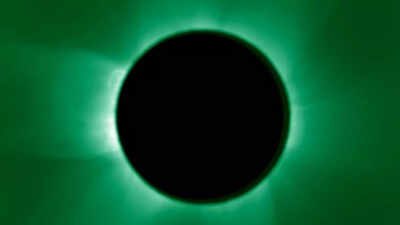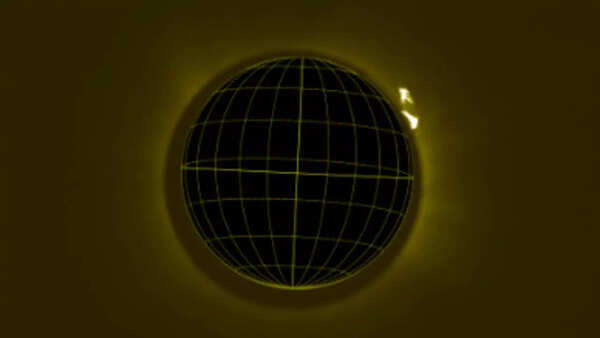ARTICLE AD BOX

The
European Space Agency
’s
Proba-3 mission
has achieved a major milestone by capturing its first images of the Sun’s faint outer atmosphere, known as the solar corona. This was made possible by two spacecraft flying in precise formation to create the world’s first
artificial solar eclipse in space
. One satellite blocked the Sun’s bright disk, allowing the second to image the hidden corona in exceptional detail. This innovative approach overcomes the limitations of ground-based observations and natural eclipses. The images offer valuable insights into solar activity, space weather, and the Sun’s influence on Earth, marking a new era in solar research.
Proba-3 creates first artificial solar eclipse in space
Proba-3 is made up of two spacecraft, the Coronagraph and the Occulter, that fly 150 metres separated in perfect synchrony. In March, the mission achieved a first ever in space: the satellites kept their alignment to within a millimetre for several hours without any intervention from ground control.This unprecedented precision is made possible by sophisticated onboard navigation and position systems, enabling the Occulter to project a perfectly aligned shadow onto the instrument of the Coronagraph, ASPIICS. During these formation-flying exercises, the 1.4-meter disk on the Occulter spacecraft eclipses the Sun's brilliant surface so that the Coronagraph's ASPIICS instrument can study the solar corona in detail. The 8 cm wide shadow on ASPIICS is all that results, but it provides a clean, unbroken view of the outer atmosphere of the Sun. Built under the leadership of ESA by a consortium led by Belgium's Centre Spatial de Liège, ASPIICS takes corona pictures without the solar glare due to its 5 cm aperture being carefully shielded.

Source: ESA
Proba-3’s early images offer new insights into solar storms
It is necessary to understand the corona in order to study solar wind and coronal mass ejections (CMEs)—great solar particle blasts that can interrupt Earth's communications, navigation systems, and power grids, as evidenced by a powerful geomagnetic storm in May 2024.The first ASPIICS pictures already suggest that the mission may bring new understanding of these lively solar phenomena. Dietmar Pilz, ESA's Director of Technology, Engineering and Quality, stressed that several of the technologies used in Proba-3 were created under the umbrella of ESA's General Support Technology Programme. "This is the world's first precision formation flying mission," stated Pilz, "and these marvelous images prove the feasibility of our technological innovation."

Source: ESA
Why the sun’s outer layer is hotter than its surface: Proba-3 looks for answers
One of the Sun's biggest secrets is how its corona is millions of degrees hotter than its surface. ASPIICS will investigate this temperature paradox by imaging regions very near the Sun with little stray light, detecting even the slightest structures.Project scientist Joe Zender says by using ASPIICS data along with onboard readings from instruments such as DARA (Digital Absolute Radiometer) and 3DEES (3D Energetic Electron Spectrometer), some of solar science's oldest mysteries will be solved.
Proba-3 achieves first eclipse on first attempt, marking a new era in solar observation
The first successful eclipse observation for the mission was on the first try. "I was really excited to see the images," stated Andrei Zhukov, ASPIICS Principal Investigator at the Royal Observatory of Belgium. His team at the ASPIICS Science Operations Centre (SOC) is developing the observation time to six hours per orbit.Each integrated image of the corona is built from three exposures of different lengths so that scientists can see both bright and dim features in a single composite. In contrast with natural eclipses that happen once or twice a year for a few minutes, Proba-3 produces an eclipse every 19.6 hours lasting up to six hours—a great step forward in solar observation technology. Mission manager Damien Galano says the spacecraft has already successfully accomplished formation flight with record accuracy. Despite still being in the commissioning phase, the mission already accomplished milestones likely to be of significant scientific significance.Full autonomous formation flying, without ground monitoring, is the last frontier the team aims for.
Proba-3’s high-resolution solar images set new benchmark
Proba-3 is also transforming the way we simulate the Sun. Its high-resolution images enable scientists to enhance computer simulations of solar eclipses used for research on solar weather.These observations are way beyond the capabilities of today's coronagraphs," said ESA's Space Weather Modelling Coordinator Jorge Amaya. The new information is fed into models such as COCONUT, created at KU Leuven, which are part of ESA's Virtual Space Weather Modelling Centre (VSWMC). These provide together the means to predict and prepare for solar impacts on our planet.
About the Proba-3 mission
Proba-3 is an ESA-led mission built by a consortium of more than 29 companies in 14 different countries, led by Sener (Spain) and with prominent roles being undertaken by GMV, Airbus Defence and Space, Redwire Space, and Spacebel. The mission was launched on 5 December 2024 onboard a PSLV-XL rocket from the Satish Dhawan Space Centre in Sriharikota, India.Also Read | NASA’s James Webb Space Telescope uncovers mysterious ‘climate system’ on Pluto regulated by strange blue haze



.png)
.png)
.png)
















 4 hours ago
3
4 hours ago
3









 English (US) ·
English (US) ·